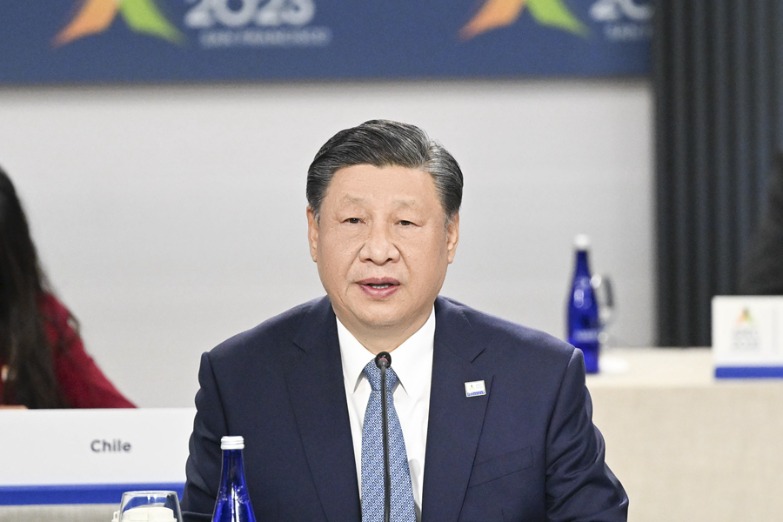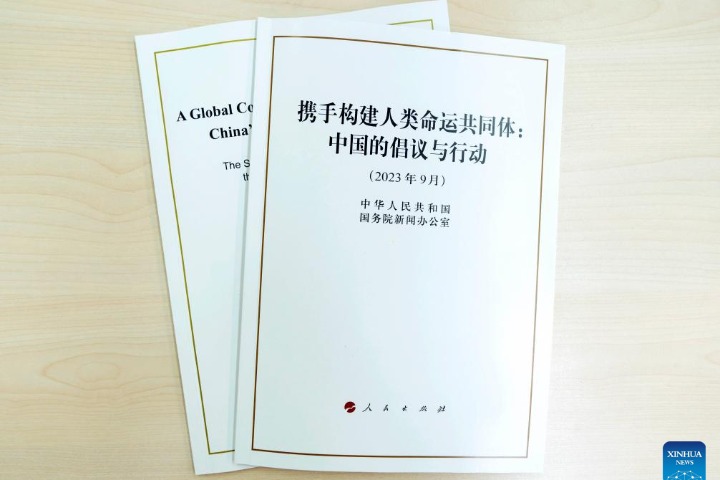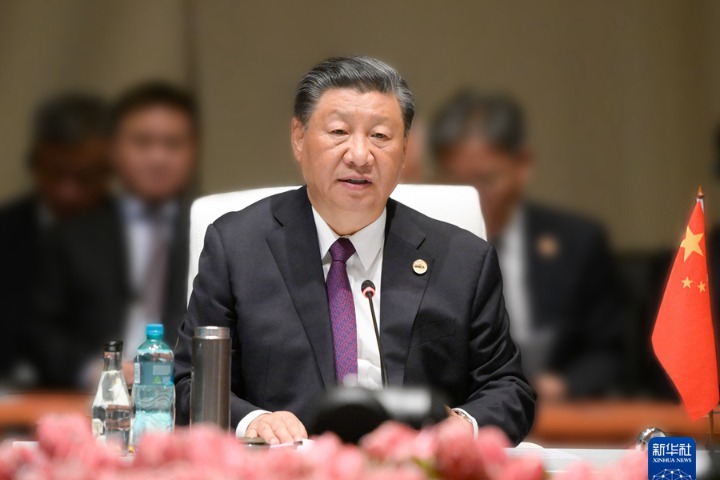新疆的若干历史问题(双语全文)
新华网 2019-07-22 09:19

五、新疆各民族文化是中华文化的组成部分
V. Xinjiang Ethnic Cultures Are Part of Chinese Culture
中华民族具有5000多年的文明发展史,各民族共同创造了悠久的中国历史、灿烂的中华文化。秦汉雄风、盛唐气象、康乾盛世,是各民族共同铸就的辉煌。多民族多文化是中国的一大特色,也是国家发展的重要动力。
The Chinese nation has a civilization that dates back more than 5,000 years. Over these five millennia, all ethnic groups of China have created a long history and a splendid culture. The prosperity of the Qin, Han and Tang dynasties and during the reign of the Kangxi and Qianlong emperors of the Qing Dynasty was achieved by all the ethnic groups together. Ethnic and cultural diversity is a salient feature of the Chinese nation and also an important driving force for China’s national development.
自古以来,由于地理差异和区域发展不平衡,中华文化呈现丰富的多元状态,存在南北、东西差异。春秋战国时期,各具特色的区域文化已大体形成。秦汉以后,历经各代,在中国辽阔的疆土上,通过迁徙、聚合、战争、和亲、互市等,各民族文化不断进行交流交融,最终形成气象恢宏的中华文化。
Since ancient times, due to geographic variations and the unbalanced development of different regions, Chinese culture has grown diverse between the south and the north and between the east and the west. As early as the Spring and Autumn and the Warring States periods, basic regional cultures with their own distinctive features had already formed. From the Qin and Han dynasties, on through all the dynasties that followed, across the vast territory of China, cultures of all ethnic groups engaged in constant exchange and integration through migration, convergence, wars, marriage, and trade, and finally formed a splendid overall Chinese culture.
早在2000多年前,新疆地区就是中华文明向西开放的门户,是东西方文明交流传播的重地,这里多元文化荟萃、多种文化并存。中原文化和西域文化长期交流交融,既推动了新疆各民族文化的发展,也促进了多元一体的中华文化发展。新疆各民族文化从一开始就打上了中华文化的印记。中华文化始终是新疆各民族的情感依托、心灵归宿和精神家园,也是新疆各民族文化发展的动力源泉。
More than 2,000 years ago and beyond, Xinjiang was a gateway for China’s civilization to open to the West and an important base for cultural exchange and communication between the East and the West. The region experienced a wealth of cultural diversity and coexistence. Long periods of exchange and integration between the culture of the Central Plains and those of the Western Regions drove not only the development of various ethnic cultures in Xinjiang, but also the diversified and integrated Chinese culture as a whole. From the very beginning, ethnic cultures in Xinjiang have reflected elements of Chinese culture, which has always been the emotional attachment and spiritual home for all ethnic groups in Xinjiang, as well as a dynamic source of development for the ethnic cultures in the region.
中原与西域的经济文化交流始于先秦时期。到汉代,汉语已成为西域官府文书中的通用语之一,琵琶、羌笛等乐器由西域或通过西域传入中原,中原农业生产技术、礼仪制度、汉语书籍、音乐舞蹈等在西域广泛传播。高昌回鹘使用唐代历书,一直延续到10世纪下半期。唐代诗人岑参的诗句“花门将军善胡歌,叶河蕃王能汉语”,是当时新疆地区民汉语言并用、文化繁荣景象的写照。宋代,天山南麓的佛教艺术依然兴盛,至今仍留有大量遗迹。西辽时期,契丹人征服喀喇汗王朝,控制新疆地区和中亚,典章礼制多沿袭中原旧制。元代,大批畏兀儿等少数民族移居内地生活,学习使用汉语,有的参加科举考试并被录用为各级官员,涌现了一批政治家、文学家、艺术家、史学家、农学家、翻译家等,有力推动了新疆各民族文化的发展。明清时期,受伊斯兰文化的影响,新疆各民族文化在同域外文化既吸收又冲突的过程中徘徊发展。近现代以来,在辛亥革命、俄国十月革命、五四运动、新民主主义革命斗争影响下,新疆各民族文化向现代转型,各民族的国家认同和中华文化认同达到新的高度。新中国成立后,新疆各民族文化进入史无前例的大繁荣大发展时期。历史证明,新疆地区凡是多语并用、交流频繁的时期,也是各民族文化勃兴、社会进步的时期。学习使用国家通用语言文字,是繁荣发展新疆各民族文化的重要历史经验。
Economic and cultural exchange between the Central Plains and the Western Regions began in the pre-Qin period. In the Han Dynasty, the Chinese language became one of the official languages used in government documents of that region. Pipa (the four-stringed Chinese lute), the Qiang flute, and other musical instruments were introduced to the Central Plains from or via the region. Agricultural production techniques, the system of etiquette, books in Chinese, and music and dances of the Central Plains spread widely in the region. Later, the Uighur Kingdom of Gaochang adopted the calendar of the Tang Dynasty, and this practice continued until the latter half of the 10th century. “The governor’s generals are skilled in the songs of ethnic minorities, and local chiefs are able to speak Chinese.” This verse by the Tang poet Cen Shen reflects the equal status of Chinese and other ethnic languages commonly used at that time. It also demonstrates the cultural prosperity of that period. Late in the Song Dynasty, Buddhist arts were still flourishing in the south of the Tianshan Mountains and a large number of relics remain till today. In the Western Liao period (1124-1218), the Khitan people, who destroyed the Kara-Khanid Khanate, controlled the Xinjiang region and Central Asia and realized regional unification, extensively inheriting and adopting the laws and regulations and etiquette of the Central Plains. In the Yuan Dynasty, large numbers of Uighurs and people of other ethnic groups migrated into the inland areas. They settled there and learned and used the Chinese language. Some of them even sat for the imperial examinations and were recruited as officials at various levels. From these groups emerged statesmen, writers, artists, historians, agronomists, translators and specialists of other types, who vigorously promoted the development of ethnic cultures in Xinjiang. During the Ming and Qing dynasties, under the influence of Islamic culture, ethnic cultures in Xinjiang developed slowly in integration and conflict with cultures from outside the region. In modern China, under the influence of the Revolution of 1911, the October Revolution in Russia, the May 4th Movement, and the New Democratic Revolution, ethnic cultures in Xinjiang began to modernize, and the Chinese national and cultural identity of all ethnic groups in the region reached a new height. After the founding of the PRC in 1949, ethnic cultures in Xinjiang entered a period of unprecedented prosperity and development. The historical record indicates that when multiple languages were used as official languages and when exchanges were frequent in Xinjiang, it witnessed a boom in ethnic cultures and social progress. Long years of experience shows that learning and using standard Chinese as a spoken and written language has helped Xinjiang’s ethnic cultures to flourish.
新疆各民族文化始终扎根中华文明沃土,是中华文化不可分割的一部分。早在伊斯兰文化传入新疆之前,包括维吾尔族文化在内的新疆各民族文化已在中华文明沃土中枝繁叶茂。源自7世纪的阿拉伯文明体系的伊斯兰文化,直到9世纪末10世纪初,随着伊斯兰教传入西域才对新疆各民族文化发生影响。宗教对文化的影响,既有自愿接受的途径,也有通过文化冲突甚至宗教战争的强制方式。在新疆,伊斯兰教很大程度上是通过后一种方式进入,这导致佛教流行时期创造的新疆各民族文化艺术遭到严重破坏。伊斯兰文化传入新疆,新疆各民族文化既有抵制,更有选择性吸收和中国化改造,既没有改变属于中华文明的特质和走向,也没有改变属于中华文化一部分的客观事实。产生于9世纪至10世纪的英雄史诗《玛纳斯》,经过柯尔克孜歌手世代传唱与加工,成为享誉中外的文学巨著。15世纪前后,蒙古族卫拉特英雄史诗《江格尔》在新疆地区逐渐形成,与《玛纳斯》《格萨尔王传》一起被誉为中国少数民族3部最著名的史诗。维吾尔族文学佳作纷呈,代表作《福乐智慧》《真理的入门》《突厥语大词典》《十二木卡姆》等,都成为中华文化宝库中的珍品,新疆各民族对中华文化的形成和发展都作出了贡献。
The ethnic cultures in Xinjiang always have their roots in the fertile soil of Chinese civilization and make up an inseparable part of Chinese culture. Well before Islamic culture spread into Xinjiang, all ethnic cultures in the region, including the Uygur culture, had prospered in the fertile soil of China’s civilization. It was not until the turn of the 9th and 10th centuries, when Islam spread into the region, that the Islamic culture of the Arab civilization – which dates back to the 7th century – began to exert an influence on ethnic cultures in Xinjiang. Religion can exert an influence on culture in two ways: willing acceptance, and forced acceptance through cultural conflict or even religious wars. In the case of Xinjiang, Islam entered mainly through the latter. This caused serious damage to the cultures and arts of the various ethnic groups in Xinjiang created in earlier periods when Buddhism was popular in the region. As to the incoming Islamic culture, the ethnic cultures in Xinjiang both resisted and assimilated it in a selective manner, and adapted it to China’s realities. This did not alter the fact that ethnic cultures in Xinjiang were ingrained with Chinese features, nor did it halt the flow of local cultures into Chinese civilization, or change the fact that they were part of Chinese culture. The epic Manas, which originated in the 9th and 10th centuries, became a literary masterpiece well-known in and outside China, thanks to performances and adaptation by Kirgiz singers. Around the 15th century, the epic Jangar of the Oirat Mongols gradually took shape in Xinjiang. These two epics, together with Life of King Gesar, are regarded as the three most renowned epics of China’s ethnic minority groups. Uygur literature has given birth to a galaxy of excellent works, including KutadguBilig (Wisdom of Fortune and Joy), Atebetu’lHakayik (A Guide to Truth), A Comprehensive Dictionary of Turkic Languages, and Twelve Muqams, all of which are treasures of Chinese culture. They represent the enormous contribution that ethnic groups in Xinjiang have made to the formation and development of Chinese culture.
中华文化认同是新疆各民族文化繁荣发展之基。历史上,凡是中央王朝对新疆进行有效治理、社会稳定的时期,新疆各民族文化和中原文化的交流交融就畅通,经济文化就繁荣兴旺;凡是新疆各民族文化秉承中华文化崇仁爱、重民本、守诚信、讲辩证、尚和合、求大同的思想,对多元文化吸收融合、兼收并蓄,多元一体的特征就越明显,新疆各民族文化就越进步。新疆各民族文化要繁荣发展,必须与时俱进,树立开放、包容理念,坚持与中华各民族文化交流融合,与世界多民族文化交流互鉴,建设各民族共有精神家园。
Having a stronger sense of identity with Chinese culture is essential to the prosperity and development of ethnic cultures in Xinjiang. Throughout history, whenever the central government exercised effective governance over Xinjiang and the society of the region was stable, exchanges and communication between ethnic cultures in Xinjiang and the culture of the Central Plains ran smoothly, and the economy and culture of Xinjiang flourished and grew prosperous. Whenever ethnic cultures in Xinjiang assimilated, integrated and accommodated the diverse culture of the Central Plains, including the concepts of benevolence, people-orientation, integrity, sound reasoning, harmony and unity, diversity and integration of Xinjiang ethnic cultures were more apparent, and these cultures could make more progress. For the ethnic cultures in Xinjiang to prosper and develop they must keep pace with the times, be open and inclusive, engage in exchange and integration with other ethnic cultures in China and mutual learning with other ethnic cultures throughout the world, and play their role in fostering a shared spiritual home for all China’s ethnic groups.
六、新疆历来是多种宗教并存的地区
VI. Multiple Religions Have Long Coexisted in Xinjiang
中国自古以来就是多宗教的国家,除了组织性、制度性较强的几大宗教外,还存在大量的民间信仰。除了道教和民间信仰是中国土生土长的之外,其他都由国外传入。新疆地区历来也是多种宗教信仰并存,一教或两教为主、多教并存是新疆宗教格局的历史特点,交融共存是新疆宗教关系的主流。
China has long been a multi-religious country. In addition to several major religions that are structured in accordance with strict religious norms, a variety of folk beliefs are also popular in China. Among these, Taoism and local folk beliefs are native to China, while all other religions were introduced from foreign countries. The history of Xinjiang shows that multiple religions have long coexisted there, with one or two predominant. The region’s religious structure is characterized by blending and coexistence.
新疆多种宗教并存格局形成和演变经历了漫长的历史过程。早在公元前4世纪以前,新疆流行的是原始宗教。大约公元前1世纪,佛教传入新疆地区,4世纪至10世纪,佛教进入鼎盛时期。同期,祆教流行于新疆各地。至16世纪末17世纪初,藏传佛教在北疆地区逐渐兴盛起来。道教于5世纪前后传入新疆,主要盛行于吐鲁番、哈密等地,至清代传播至新疆大部分地区并一度复兴。摩尼教和景教于6世纪相继传入新疆。10世纪至14世纪,景教随着回鹘等民族信仰而兴盛。
The formation and evolution of the coexistence of multiple religions in Xinjiang has been a long process:
• Prior to the 4th century BC, primitive religion was widespread in Xinjiang.
•Around the 1st century BC, Buddhism was introduced into Xinjiang.
•From the 4th to 10th centuries, Buddhism reached its peak, while Zoroastrianism proliferated throughout Xinjiang.
•During the late 16th century and early 17th century, Tibetan Buddhism thrived in northern Xinjiang.
•Around the 5th century, Taoism spread into Xinjiang, prevalent in Turpan and Hami areas. During the Qing Dynasty, it revived in most parts of Xinjiang.
•In the 6th century, Manichaeism and Nestorianism entered Xinjiang. From the 10th to 14th centuries, Nestorianism flourished as the Uighur and some other peoples converted to it.
9世纪末10世纪初,喀喇汗王朝接受伊斯兰教,并于10世纪中叶向信仰佛教的于阗王国发动40余年宗教战争,11世纪初攻灭于阗,强制推行伊斯兰教,结束了佛教在这个地区千余年的历史。随着伊斯兰教的不断传播,祆教、摩尼教、景教等宗教日趋衰落。14世纪中叶,东察合台汗国统治者以战争等强制手段,将伊斯兰教逐渐推行到塔里木盆地北缘、吐鲁番盆地和哈密一带。至16世纪初,新疆形成了以伊斯兰教为主要宗教、多种宗教并存的格局并延续至今,原来当地居民信仰的祆教、摩尼教、景教等逐渐消失,佛教、道教仍然存在。17世纪初,卫拉特蒙古人接受了藏传佛教。约自18世纪始,基督教、天主教、东正教相继传入新疆。
In the late 9th century and early 10th century, the Kara-Khanid Khanate accepted Islam. It started a 40-year-long religious war in the mid-10th century against the Buddhist Kingdom of Khotan, and conquered it in the early 11th century and imposed Islam there, putting an end to the thousand-year history of Buddhism in that region. With the expansion of Islam, Zoroastrianism, Manichaeism, and Nestorianism declined. In the mid-14th century, the rulers of the Eastern Chagatai Khanate (1348-1509) spread Islam to the northern edge of the Tarim Basin, the Turpan Basin and Hami through war and duress. By the early 16th century, many religions had coexisted in Xinjiang, with Islam predominant, Zoroastrianism, Manichaeism, and Nestorianism gone, and Buddhism and Taoism surviving. The coexistence has continued to this day in the region. In the early 17th century, the Oirat Mongols accepted Tibetan Buddhism. Beginning in the 18th century, Protestantism, Catholicism, and the Eastern Orthodox Church reached Xinjiang.
新疆现有伊斯兰教、佛教、道教、基督教、天主教、东正教等宗教。清真寺、教堂、寺院、道观等宗教活动场所2.48万座,宗教教职人员2.93万人。其中,清真寺2.44万座,佛教寺院59座,道教宫观1座,基督教教堂(聚会点)227个,天主教教堂(聚会点)26个,东正教教堂(聚会点)3座。
Xinjiang now has multiple religions, including Islam, Buddhism, Taoism, Protestantism, Catholicism, and the Eastern Orthodox Church. It has 24,800 venues for religious activities, including mosques, churches, Buddhist and Taoist temples, with 29,300 religious staff. Among these, there are 24,400 mosques, 59 Buddhist temples, 1 Taoist temple, 227 Protestant churches (or meeting grounds), 26 Catholic churches (or meeting grounds), and 3 Orthodox churches (or meeting grounds).
同世界上大多数国家一样,中国坚持政教分离原则。任何宗教不得干预政治、干预政府事务,不得利用宗教干预行政、司法、教育、婚姻、计划生育等,不得利用宗教妨碍正常社会秩序、工作秩序、生活秩序,不得利用宗教反对中国共产党和社会主义制度、破坏民族团结和国家统一。
China, along with most other countries, upholds separation of religion from government. No religious organization is allowed to interfere in political and government affairs. No individual or organization is allowed to use religion to interfere in administration, judicial affairs, education, marriage and birth control, to hinder social order, work order and life order, to oppose the Communist Party of China and China’s socialist system, or to undermine ethnic solidarity and national unity.
新疆全面贯彻国家宗教信仰自由的宪法原则,既尊重信仰宗教的自由、又尊重不信仰宗教的自由,决不允许在信教和不信教、信这种教和信那种教、信这一教派和信那一教派群众之间制造纷争。新疆始终坚持各宗教一律平等,对所有宗教一视同仁,不偏袒某个宗教,也不歧视某个宗教,任何宗教不得享有超越其他宗教的特殊地位。新疆始终坚持法律面前人人平等,信教群众和不信教群众享有同等权利、履行同等义务,无论什么人、哪个民族、信仰什么宗教,只要违法,就必须依法处理。
Xinjiang fully respects and protects freedom of religious belief as stipulated in the Constitution of the PRC. Xinjiang respects citizens’ freedom to believe in, or not to believe in, any religion. Xinjiang shows zero tolerance to any action that creates disputes between believers and non-believers, between believers of different religions, and between believers of different sects of a religion. Xinjiang always upholds equality for all religions, showing neither favoritism towards nor discrimination against any religion and allowing no religion to be superior to any other religion. Xinjiang always upholds equality for all individuals before the law. Believers and non-believers enjoy equal rights and obligations, and all law violators, whatever their social background, ethnicity, and religious belief, will be punished in accordance with the law.
同所在社会相适应是宗教生存发展的趋势和规律。中国宗教发展的历史证明,只有坚持中国化方向,宗教才能更好地与中国社会相适应。新中国成立70年的历史也证明,宗教只有与社会主义社会相适应,才能健康发展。必须坚持独立自主自办原则,防止一切“去中国化”倾向。必须大力培养和提倡世俗化现代化的文明生活方式,摒弃愚昧落后的陈规陋习。必须弘扬宗教中国化的历史传统,用社会主义核心价值观引领、用中华文化浸润中国各种宗教,努力把宗教教义同中华文化相融合,积极引导包括伊斯兰教在内的各种宗教走中国化道路。
To survive and develop, religions must adapt to their social environment. The history of religions in China shows that only by adapting themselves to the Chinese context can they be accommodated within Chinese society. The 70-year history of the PRC also shows that only by adapting to socialist society can religions in China develop soundly. We must uphold the principle of independence and self-management of China’s religious affairs, and prevent all religious tendency that seeks to divest itself of all Chinese elements. We must develop and encourage secular, modern and civilized ways of life, and abandon backward and outdated conventions and customs. We must carry forward religious practices adapted to Chinese society, inspire various religions in China with core socialist values and Chinese culture, foster the fusion of religious doctrines with Chinese culture, and lead these religions, including Islam, onto the Chinese path of development.

















 英语点津微信
英语点津微信 双语小程序
双语小程序